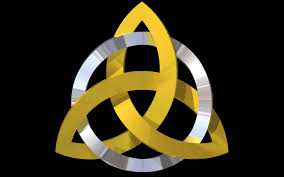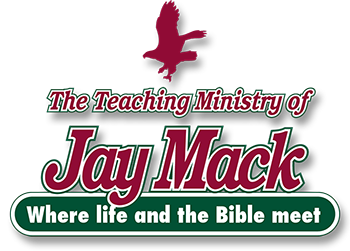Week 7: God the Father and the Trinity
God is able to be known, and at the same time, is full of incomprehensible mystery. One of those mysteries is the plurality of the Godhead. Our God, the God of the Bible, is one God in three Persons.
We call this the Trinity.
I wish I could eloquently and simply explain the mystery of the Trinity, but it is impossible. It’s like trying to explain the internet to an ant. But, despite the complexity of the plurality of the Godhead, the Trinity isn’t a liability to our faith; rather, it sets our faith apart from all other religions. Our finite minds can’t quite comprehend all of this, but I consider the Trinity to be the most beautiful and foundational truth of our faith.
Deuteronomy 6:4 declares: The LORD our God, the LORD is one (see my commentary on Deuteronomy, to see link click Bw – Sh’ma Isra’el). This is the basis of the Jewish faith, and in the Jewish mind-set, this rules out any possibility of any plurality of the Godhead. The rabbis teach that Yeshua was just a man whom YHVH adopted, and He is basically a Christian invention, and a perversion of the TaNaKh.
However, believers in Yeshua today believe that Isra’el’s God, the God we worship, is distinct and unequaled. He is not powerful over just one area of our life, but in all of life. He is sovereign, reigning over and in control of all things. He is altogether holy and set apart from everything and everyone. There is none like Him. Yet, He is infinitely faithful, making a way for us to be holy before Him, through the ministry of Himself, His Son, Yeshua Messiah, and the Ruach Ha’Kodesh. This is the delight and distinctiveness of our faith.

The word Trinity is not found in the Bible, but the concept is made clearer as we study the Bible from Genesis to Revelation. There are a dozen examples of the Trinity in the Scriptures, but three in particular are Isaiah 48:16-17, Matthew 28:19, Acts 10:38. These passages point to the Trinity as being active together, each Person coequal with the others. Each Person is eternal, having existed and will exist forever; being all-knowing (omniscient), all-powerful (omnipotent), ever-present (omnipresent), and unchanging. They are perfect in their union, sharing in divine perfection, action, and mission. There is no hierarchy with one Person being more powerful or supreme than the other.
Each Person of the Trinity is distinct from the others. The Father is not the Son or the Spirit, the Son is not the Spirit or the Father, and the Spirit is not the Father or the Son. The Father brings about the Son, and the Spirit proceeds from the Father and the Son. They are unified, and yet distinct – one God – not three gods or three views of one Person. The Trinity is an antimony, two things seemingly at odds with each other, but both are true.
They are also distinct in their roles. The Father exercises the primary role in creation (working with the Son and the Spirit to create). The Son exercises the primary role in salvation (working with the Father and the Spirit to save). The Spirit exercises the primary role in our being set apart for God’s holy purposes (working with the Father and the Son in our being conformed into the image of Christ).
God chose us in Him by His eternal plan, sent Yeshua to redeem us by shedding His blood, then sealed us with His Spirit as a down payment of our eternal security. Without the plurality of the Godhead, our faith would be in vain.
It’s OK to be a little bit baffled about the Trinity. It is a mystery that will not be completely understood until we are in heaven. But that doesn’t mean we discard or ignore it. To know God is to know Him as the Trinity. And knowing the One we worship helps us to correctly talk about, think about, and praise Him. He is an incomprehensible mystery, yet close and personal. He is the Father who generates all life, the Son who reveals the Father and saves God’s people, and the Spirit who is the Giver of eternal life, comfort, and guidance.
ADONAI is three Persons – but one God. There is a plurality of the Godhead and this belief can be clearly seen in the Torah and is confirmed by the prophets and the writings.
God the Father: Where does God dwell? The Torah teaches that God dwells in two Sanctuaries that exist at the same time without ceasing to be one God. One the one hand, after Moses oversaw the construction of the Tabernacle, the Sh’khinah glory of God moved from the top of Mount Sinai into the Tabernacle (see the commentary on Exodus Hh – The Glory of the LORD Filled the Tabernacle). And YHVH spoke to Moshe from the Tabernacle, and lives with His people (Leviticus 1:1 and 26:11-12). On the other hand, accordingly to Deuteronomy 26:15a, YHVH lives in heaven at the same time, saying: ADONAI looks down from heaven, His holy dwelling place. Therefore, according to the Torah, God lives in two places at the same time. No one would argue that means there are two Gods. So YHVH can put on Tabernacle without ceasing to be God above. This argues for a plurality of the Godhead.
But we also see this concept in the prophets where, in First Kings 8, Solomon dedicated the Temple and the Presence of God filled the Most Holy Place (see the commentary on the Life of Solomon Bj – The Ark Brought to the Temple). The king declared that he had built the LORD a magnificent house, a place where YHVH could live forever (First Kings 8:10-13). So, according to Solomon, YHVH lives in the Most Holy Place. But throughout Solomon’s prayer of dedication he also pleads that God would listen from His heavenly home (First Kings 8:30, 32, 34, 39, 43, 45, and 49). Is Solomon contradicting himself? Absolutely not! Thus, ADONAI was dwelling in the Temple and in heaven at the same time. Therefore, according to the Torah and the Prophets, God can be in two places at the same time, but still be one God!
God the Spirit: Notice that there is a plurality in the Godhead in the Torah. Genesis 1:26, says: Let us make man in our image, after our likeness. Here YHVH speaks in the plural, but some of the rabbinic apologists are very quick to say, “Well, of course this can’t refer a Divine plurality because God was speaking to the angels (Midrash Tanchuma, Shemot 18 and see Genesis Rabbah 8). But the in context of this verse there is no explicit mention of any angels. So who could God have been talking to? Was God alone in Genesis Chapter One? We believe God is One (Deuteronomy 6:4), but He is not alone! The answer is in Genesis 1:1-2, “In the beginning God created the heavens and the earth. Now the earth was formless and empty, darkness was over the surface of the deep, and the Spirit of God was hovering over the waters.” God is there, and the Spirit of God is there.
However, we also see this concept in the writings where, Proverbs 8:27-31 describes the Spirit as a Person. “I was there when He set the heavens in place, when He marked out the horizon on the surface of the deep,when He established the clouds above and fixed securely the fountains of the deep, when He gave the sea its boundary so the waters would not overstep His command, and when He marked out the foundations of the earth. Then I was constantly at His side, as a Master Workman. I was filled with delight day after day, rejoicing always in His presence, rejoicing in His whole world and delighting in mankind.” Proverbs makes the relationship between God the Father and God the Spirit explicit. At the creation of the world, theywere there together. God created the world through wisdom. In addition, everywhere in the Bible there is an association between the Spirit and wisdom (Proverbs 3:19; Psalm 104:24 and 30; Job 33:4). In the Jerusalem Targum, Genesis 1:1 and Genesis 1:27 are combined to say, “In the beginning with wisdom ADONAI created . . . and the Memra of ADONAI created man in His image.” In the beginning with wisdom, the son of ADONAI created mankind in His image (Tragum Neofeti). So you have, in the very first chapter in the Torah, a plurality of the Godhead.
God the Son: In the Torah, we not only see God the Father, and God the Spirit, but also God the Son. In Exodus 3:2 we read that the Angel of ADONAI (see below) appeared to him in a fire blazing from the middle of a bush. Messiah is called the Angel of ADONAI 58 times and He is called the Angel of God 11 times. This is never a common angel, but the second Person of the Trinity, Yeshua. Thus, is always a reference to the pre-incarnate Messiah. Significantly, the rabbis teach that the phrase the Angel of ADONAI is sometimes used to denote God Himself. So just like God can live in animal skin (see the commentary on Exodus Fl – The Goat Hair Curtains on the Sanctuary), He can also dwell in a bush.
The Angel of ADONAI appeared to Moshe in a blazing fire from the midst of a bush, he looked and saw that although the bush was flaming with fire, yet the bush was not being burned up. Moshe said, “I’m going to go over and see this amazing sight and find out why the bush isn’t being burned up.” When ADONAI saw that he had gone over to see, God called to him from the middle of the bush, “Moshe! Moshe!” He answered, “Here I am.” He said, “Don’t come any closer! Take your sandals off your feet, because the place where you are standing is holy ground. I am the God of your father,” he continued, “the God of Abraham, the God of Isaac and the God of Jacob.” Moshe covered his face, because he was afraid to look at God (Exodus 3:2-6). So, the preincarnate Messiah appears from the midst of the bush, but in the rest of Chapter Tree, God the Father talks to Moses.
But we also see this concept in the prophets where, in Judges 6:12-16, when the Angel of ADONIA appeared to Gideon, He said, “The LORD is with you, mighty warrior” (6:12). “Pardon me, my lord,” Gideon replied, “but if the LORD is with us, why has all this happened to us? Where are all his wonders that our ancestors told us about when they said: Did not the LORD bring us up out of Egypt? But now He has abandoned us and given us into the hand of Midian” (6:13). The LORD turned to him and said, “Go in the strength you have and save Isra’el out of Midian’s hand. Am I not sending you” (6:14)? “Pardon me, my LORD,” Gideon replied, “but how can I save Isra’el? My clan is the weakest in Manasseh, and I am the least in my family” (6:15). The LORD answered him, saying, “I will be with you, and you will strike down all the Midianites, leaving none alive” (6:16).
The text sometimes identifies the speaker as the LORD in verses 14 and 16, and the Angel of ADONAI, or the pre-incarnate Messiah in verse 12, and later in verses 20-21. Indeed Gideon’s visitor sometimes speaks in the first person of the LORD in verses 14 and 16, and sometimes in the third person in verse 12. One might want to argue that the LORD was located in heaven and spoke through a lower ranking divine being sent to earth with a message, but it is specifically the LORD who turned His face toward Gideon in verse 14. At the same time, we are told in verse 22 that Gideon saw the Angel of ADONAI, and even though it was the LORD who turned His face toward Gideon, it was the Angel of ADONAI who left the place in verse 21. All this can be confusing unless you view the Angel of ADONAI as being the preincarnate God the Son, and the LORD as being God the Father.
Furthermore, the Torah presents Yeshua as a man. Now YHVH appeared to Abraham near the great trees of Mamre while he was sitting at the entrance to his tent in the heat of the day. Abraham looked up and saw three men standing nearby. When he saw them, he hurried from the entrance of his tent to meet them and bowed low to the ground. He said, “If I have found favor in your eyes, and identifying one of the three as my YHVH, do not pass your servant by” . . . then the men turned away and went toward Sodom, but Abraham remained standing before YHVH (Genesis 18:1-3 and 22). So the Torah teaches that God can appear as a man, but that didn’t prevent YHVH from being God in heaven at the same time. Therefore, the Trinity is in total conformity with what the Torah teaches if you just read what it teaches in context.
And in the B’rit Chadashah, John tells us that in the beginning was the Word, and the Word became flesh and tabernacled among us; and the Word was with God and we have seen His glory, the glory of the one and only Son, who came from the Father; and the Word was God, full of grace and truth. How is that different than the Torah? Therefore, according to the Bible, God tabernacles in animal skin (see above) and tabernacles in human skin (John 1 and 14). Finally, the Church has believed in the Trinity for 21 Centuries. Cults never believe in the Trinity. Therefore, to be a believer, is to believe in the Trinity!
Study questions for Lesson Seven: God the Father and the Trinity
Can God be known? Yes
Is God a mystery? Yes
What do we call this mystery? The Trinity, One God in three Persons
Can our finite minds explain this mystery? No
Is the word Trinity found in the Bible? No
Then how is the concept made clear? When we study the Bible from Genesis to Revelation
What Scriptures point to the Trinity? Deut 6:4, Isaiah 48:16-17, Matthew 28:19, Acts 10:38
Is there a hierarchy within the Trinity? No, they are all co-equal
Is each person of the Trinity distinct from each other? Yes
Do they have different roles? Yes
What is the primary role of the Father? The Father exercises the primary role in creation
What is the primary role of the Son? The Son exercises the primary role in salvation
What is the primary role of the Spirit? Being set apart for God’s holy purposes
Is it ok to be a little baffled by the Trinity? Yes
When will we understand it completely? When we get to heaven
Can you be a believer and not believe in the Trinity? No!



Leave A Comment